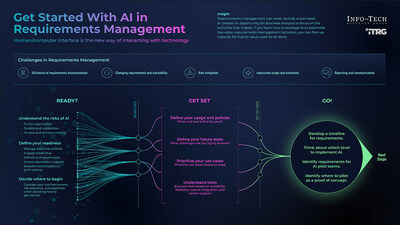Info-Tech’s new research emphasizes the potential of AI in requirements management. The firm’s blueprint provides a strategic guide for business analysts to effectively adopt AI to optimize business processes and decision-making.
TORONTO, Jan. 22, 2024 /PRNewswire/ – The ongoing integration of artificial intelligence (AI) into requirements management represents an opportunity to enhance efficiency and accuracy in software development. Recognizing the strategic potential of AI, industry leaders are embracing this transformation despite the substantial changes it brings to organizational workflows. With AI’s potential to boost productivity and streamline development processes, organizations face a pressing need for robust AI support to overcome the complexities, potential pitfalls, and uncertainties that can arise during AI adoption. The revolution in requirements management signifies a new era in which business analysts can focus on strategic tasks, driving overall project success for the organizations they support. A new blueprint from Info-Tech Research Group, Get Started With AI in Requirements Management, serves as a practical guide for business analysts to leverage AI for automating routine tasks and dedicating more time to strategic, high-impact activities.
“AI isn’t coming; it is already here. Business analysts must prepare themselves to help their organizations in adapting to this game-changing technology,” says Vince Mirabelli, principal research director at Info-Tech Research Group. “AI is set to completely revolutionize the practice of requirements management, offering opportunities for unparalleled efficiency and precision in the solution development lifecycle. However, organizations should approach AI implementation with a thoughtful and cautious strategy. The right way to embark on this journey involves understanding the constraints and limitations of AI, ensuring data quality and diversity to prevent biased outcomes, and incorporating human oversight throughout the process.”
While the market is abundant with numerous tools and vendors promising significant productivity benefits, the firm advises in the new resource that the key for business analysts lies in how to effectively leverage these technologies to align with organizational goals. Without a clear, strategic plan or well-defined objectives, investments in AI risk being ill spent, leading to suboptimal outcomes despite significant expenditure of time, money, and effort.
The research also addresses a prevalent concern about job displacement across industries due to AI adoption. Info-Tech’s blueprint provides insights into how AI can complement and enhance human roles rather than replace them, emphasizing the importance of strategic planning and human-centric AI implementation. The approach not only mitigates the risks associated with AI integration but also positions the organization to capitalize on AI’s potential to drive innovation and maintain a competitive edge.
To guide business analysts toward successful AI adoption in requirements management, Info-Tech’s blueprint outlines several key phases to ensure a thoughtful and effective integration of AI:
- Assessment of AI Readiness and Risks: This phase involves evaluating the organization’s current state in terms of readiness to adopt AI, including an understanding of the potential risks and rewards. The assessment phase includes the following actions business analysts can take:
o Understanding the Risks of AI: Assess the potential impact of AI on the organization, its effect on skills and capabilities, and implications for data and decision-making.
o Defining Readiness: Prepare for AI integration by managing data and artifacts, engaging leadership, adhering to AI governance, involving operational support, and broadening team capability and capacity.
o Deciding Where to Begin: Evaluate the organization’s risk frameworks, risk tolerance, and readiness to determine the starting point for AI adoption. - Define AI Strategy and Objectives: In this phase, the focus shifts to setting clear, strategic objectives for AI adoption, aligning AI initiatives with the broader goals of the organization, and preparing the groundwork for implementation. The activities of this phase include:
o Defining Usage and Policies: Establish clear guidelines on what AI will be used for and how it will be applied within the organization.
o Defining Future State: Identify the challenges that AI should address and envision the desired future state after AI integration.
o Prioritizing Use Cases: Select AI use cases based on organizational needs and potential impact.
o Understanding Tools: Evaluate available AI tools considering scalability, flexibility, ease of integration, and vendor support. - Implement and Execute: The final phase involves the actual implementation of AI solutions, followed by continuous monitoring and adjustments to ensure they meet the set objectives and deliver value. The implementation activities of this phase include the following:
o Developing a Timeline for Requirements: Outline a clear timeline for integrating AI into requirements management.
o Determining Level of Implementation: Decide on the level at which AI will be implemented within the organization.
o Identifying Requirements for AI Pilot Teams: Determine the specific needs and requirements for teams piloting AI projects.
o Piloting Proof of Concept: Select appropriate areas within the organization to conduct a pilot as proof of concept for AI implementation.
By following this structured approach, business analysts and their organizations can successfully navigate the complexities of AI integration in requirements management. This enables them to effectively leverage AI to enhance their requirements management processes, ensuring that it serves as a powerful tool for efficiency and innovation rather than a disruptive force.
For exclusive and timely commentary from Vince Mirabelli, an expert in strategic business analysis, or access to the complete Get Started With AI in Requirements Management blueprint, please contact [email protected].
About Info-Tech Research Group
Info-Tech Research Group is one of the world’s leading information technology research and advisory firms, proudly serving over 30,000 IT professionals. The company produces unbiased and highly relevant research to help CIOs and IT leaders make strategic, timely, and well-informed decisions. For more than 25 years, Info-Tech has partnered closely with IT teams to provide them with everything they need, from actionable tools to analyst guidance, ensuring they deliver measurable results for their organizations.
Media professionals can register for unrestricted access to research across IT, HR, and software and hundreds of industry analysts through the firm’s Media Insiders program. To gain access, contact [email protected].
For information about Info-Tech Research Group or to access the latest research, visit infotech.com and connect via LinkedIn and X.
![]() View original content to download multimedia:https://www.prnewswire.com/news-releases/new-ai-study-released-how-business-analysts-can-gain-a-competitive-edge-using-emerging-technology-published-by-info-tech-research-group-302041011.html
View original content to download multimedia:https://www.prnewswire.com/news-releases/new-ai-study-released-how-business-analysts-can-gain-a-competitive-edge-using-emerging-technology-published-by-info-tech-research-group-302041011.html
SOURCE Info-Tech Research Group

Featured image: Megapixl © Solarseven









